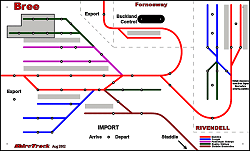Then...
For many years control of the railway was achieved using the traditional method of block control. The layout was divided into independent electrical track sections or 'blocks', each controlled via a switch that turned on or off the variable 0-12V DC power from the controllers.
Control panels, located at the main stations, grouped switches together on a graphical representation of their respective region of the railway, along with buttons that controlled the operation of the points. The control panels were able to import and export power to and from adjacent panels, enabling one controller to operate a locomotive from one end of the layout to the other without interruption.
This relatively simple system was quick and cheap to set up and maintain but resulted in lots of wiring, much setting of switches and limited locomotive movements to one per controller.
Now...
In 2011 a major upgrade to the layout's control system commenced with the installation of the MERG CBUS layout control system. Phase One, completed in October 2012, replaced all the point and signalling wiring with networked CBUS control modules, enabling the introduction of computer monitoring and control of the layout whilst retaining the traditional control panel operation.
Phase Two was the conversion of the locomotives and track from DC to DCC (Digital Command and Control). Given the scale of the task this, like Phase One, was undertaken in stages, starting at one end converting one station at a time. Additional CBUS modules were installed, such as track occupancy detectors and point position feedback, and the control panels redesigned and replaced.
This section describes both the current CBUS installation and the former block control method.
Operating Principle of Regional Control
Control of the railway is divided into five regions, with each operated via a dedicated control panel. Each region is centred on one of the five main stations modelled in the layout and may include nearby smaller stations, junctions, and other track features. For example, the Hobbiton region comprises Hobbiton station, where the control panel is located, as well as Overhill and Tuckbrough stations, the Hobbiton mine, Bywater Junction and all the track connecting these locations.

The primary role of a panel is to group together and organise, within a graphical representation of its region, the buttons which govern the operation of points. Additionally, using LEDs, the panels installed as part of the CBUS system display the status of points and signals as well as indicating when a section of track is occupied by a locomotive or train.

